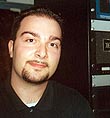|
|
This topic comprises 5 pages: 1 2 3 4 5
|
|
Author
|
Topic: Dolby Fader Levels
|
|
|
|
|
Ken Lackner
Phenomenal Film Handler

Posts: 1907
From: Atlanta, GA, USA
Registered: Sep 2001
|
 posted 01-01-2003 11:21 AM
posted 01-01-2003 11:21 AM




That's exactly what my question was about! ![[Smile]](smile.gif) Yeah, my theater has most of it's faders down in the 5 range. Yeah, my theater has most of it's faders down in the 5 range. ![[Frown]](frown.gif) We get way too many volume complaints when we go much above 6. Our tech does have the processors properly calibrated. So if films are intended to be run at 7, why so many volume complaints?? We get way too many volume complaints when we go much above 6. Our tech does have the processors properly calibrated. So if films are intended to be run at 7, why so many volume complaints??
So if I understand you correctly, a jump from one level to the next (3 to 4, 4 to 5, 5 to 6, etc...) does not correspond to any specific dB level?
quote:
Now having 7.0 corresspond to 85dB was fine for analog with only 6dB more of level (91dB)...with Digital and nearly 20dB more level left...many are reducing their faders down to the 4-5 range
I really don't understand what you mean by that. (Not the part about people reducing their faders, I just said that my theaterd does that too!)
quote:
If so, then they predate Dolby by quite a long time
So whered did this standard come from?
| IP: Logged
|
|
Steve Guttag
We forgot the crackers Gromit!!!

Posts: 12814
From: Annapolis, MD
Registered: Dec 1999
|
 posted 01-01-2003 11:44 AM
posted 01-01-2003 11:44 AM




It isn't so much of a standard as a convienient way of numbering any gerneric fader...even THIS IS SPINAL TAP made fun of the way faders are numbered by making note that Marshall amps have their faders go to 11! To which the reporter asked...well why not make that "10" and renumber it?
So yes, the numbers have no correllation to a dB change. You will find knobs having a 0-10 scale though out their history. Some have called their faders "attenuators" and number them from -infinity to 0dB (no attenuation). For a simple pot that is correct. People don't normally work well with negatives so you wouldn't want to tell people to "set your faders to -5". It is easier to set to 5 or 7. Sony decided to have their fader on the dB scale with "0" being normal, or equivalent to "7" everywhere else. They only gave you a +/- 10 dB range and a knob resolution such that you needed a Makita to spin it down to -10 as fast as you could to get people's ears to stop bleeding. When they came out with the 3000 series they now have +10 but -30 dB. Note the Sony method hasn't taken in the Cinema Industry....Peavey tried something similar with their CinemaAcoustics stuff...a "0" ref with +/- from that.
The pro sound guys try to just bring in their ways and this industry just doesn't change that fast.
SMART took a rather interesting approach on some of their processors...the ModIII only had ONE marking on it..."CAL"...which was used for calibration only. After all, you will turn the knob up or down to satisfy whatever complaints you are having. Since the numbers have no correllation to anything anyway, what difference does it make? (The ability to set things uniformly comes to mind)
So as to digital...if you are mixing a film you are going to get your dialogue levels right and hopefully that will be right for any format of sound...mono though digital. Then the music and effects are added, and added, and added...I little known feature of film mixing consoles are the fader rachets...just like on a roller coaster, once a fader has been slid up...
it may never be brought down again ! Thus films only get louder from there. As the recordest is exposed to these insane levels longer, the less sensitive they get to it and they climb yet higher! Even the dialogue will start getting boosted so as to not get lost on all of these expensive and impressive music and effects.
When you only had 6dB more of range from reference, well that is all you could go up. With 20 dB more, you have a lot more sound you can put down and, unfortunately, they do! I love a loud "sting" as much as the next guy but when the whole damn film is loud...it actually takes away from the track...nothing is emphasized since it ALL is.
So what does 90% of all theatres do...they reduce their fader...for the most part that works but the big explosions are less big and more importantly, the dialogue is reduced to the point where I find it too soft.
Steve
| IP: Logged
|
|
|
|
|
|
Christopher Seo
Jedi Master Film Handler

Posts: 530
From: Los Angeles, CA
Registered: Jun 99
|
 posted 01-01-2003 02:21 PM
posted 01-01-2003 02:21 PM




I understand your general arguments... I am, rather, confused about a specific statement you made, the same one that Ken mentions:
quote:
Now having 7.0 corresspond to 85dB was fine for analog with only 6dB more of level (91dB)...with Digital and nearly 20dB more level left...many are reducing their faders down to the 4-5 range...which is not what the original intention was.
You are implying that the increased amount of headroom available with digital makes 7.0 a poor fader setting choice, whereas it is acceptable for optical analog. What is specifically wrong with "having 7.0 correspond to 85 dB," and what do you think would be a better choice?
As far as the Dolby fader characteristic, I was just wondering how well the faders are calibrated; i.e., can I really expect lowering the fader from 7 to 6 to yield a precise 3-1/3 dB reduction in SPL, especially with analog faders. I would imagine a discrete shaft-encoded digital fader to be more precise in this regard. I know the precision is not critical as long as one knows what is relatively good levels, but it's nice to know that when the editor of a film yells for 2 dB more, one can set the fader accordingly.
| IP: Logged
|
|
|
|
|
|
|
|
|
|
|
|
|
|
|
|
Steve Guttag
We forgot the crackers Gromit!!!

Posts: 12814
From: Annapolis, MD
Registered: Dec 1999
|
 posted 01-01-2003 05:30 PM
posted 01-01-2003 05:30 PM




Obviously, something is being lost in the ASCII translation here.
I am NOT advocating lowering the reference level at all. What I am saying is if the recording engineer only has 6dB available of extra headroom for explosions, music and effects, that is what they seem to use...with digital, they have 20dB and that is what they seem to use ALL THE DAMN TIME.
The problem isn't with the reference level...it provides a wonderful dynamic range to give the ability of the recording engineer to make loud things loud, soft things soft and everything in between....by lowering the fader, you have, in effect, squashed the dynamic range of the system.
This is not the exhibitor's fault. The problem lies with the recording engineers! They don't leave that 20 dB of headroom alone and keep it in reserve for the really BIG LOUD STUFF.
So if you have a guy that records dialogue at a comfortable and natural level but will always record music and effects at the top-end of whatever medium he has, then with a digital track it will be way too loud...with an older optical track it will only be 6dB louder...the track in effect, put a "governor" on his mix board.
Dolby made a nifty gadget which has been dubbed the "annoyance" meter. It merely gives an ongoing account of the relative level of a film over time. It doesn't correspond to dB persay but some propritary level called Leqm.
What it does is measure the soundtracks for the entire length...and comes up with a single number represenation...the higher the number the louder the film overall.
Its nifty since the weight of any part of a film is proportional to the length of an entire film. If you have a 3 hour epic, then a short 1 minute bang em up sequence will not drive your number up substantially.
This device has been in use now with the mixing of trailers and has contributed to lowering the overall level....with a trailer the entire feature is only a couple of minutes so each loud passage represents a major portion of the score.
If the industry adopted the use of this device on mixing features and put requirements on its use in order to receive an MPAA rating and basically put a watch dog on the recording engineer, the excessive levels would come to an end.
Yes, Adam does bring up valid points...the acoustics of the theatre and tuning definately contribute to the harshness of the track too.
As to accurate...the analog faders can be quite accurate...the older ones made with discrete components were less so. Digital faders offer the flexibility of programing the exact response of the fader over it's entire range. With an analog fader, you are even depending on how well the index line was put on the knob.
Steve
| IP: Logged
|
|
|
|
All times are Central (GMT -6:00)
|
This topic comprises 5 pages: 1 2 3 4 5
|
Powered by Infopop Corporation
UBB.classicTM
6.3.1.2
The Film-Tech Forums are designed for various members related to the cinema industry to express their opinions, viewpoints and testimonials on various products, services and events based upon speculation, personal knowledge and factual information through use, therefore all views represented here allow no liability upon the publishers of this web site and the owners of said views assume no liability for any ill will resulting from these postings. The posts made here are for educational as well as entertainment purposes and as such anyone viewing this portion of the website must accept these views as statements of the author of that opinion
and agrees to release the authors from any and all liability.
|

 Home
Home
 Products
Products
 Store
Store
 Forum
Forum
 Warehouse
Warehouse
 Contact Us
Contact Us




 Printer-friendly view of this topic
Printer-friendly view of this topic






![[Smile]](smile.gif) Yeah, my theater has most of it's faders down in the 5 range.
Yeah, my theater has most of it's faders down in the 5 range. ![[Frown]](frown.gif) We get way too many volume complaints when we go much above 6. Our tech does have the processors properly calibrated. So if films are intended to be run at 7, why so many volume complaints??
We get way too many volume complaints when we go much above 6. Our tech does have the processors properly calibrated. So if films are intended to be run at 7, why so many volume complaints??








